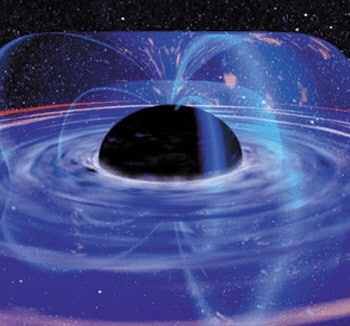Quantum information could be retrieved from a black hole, according to new calculations by a theoretical physicist in the US. Seth Lloyd of the Massachusetts Institute of Technology has found that only a tiny amount of information -- just half a quantum bit, or "qubit" -- is lost from the black hole regardless of how many bits are in the hole to begin with. The unexpected discovery means that a black hole could behave as a good quantum computer and be used to perform useful calculations -- if only we knew how to program it (Phys. Rev. Lett. 96 061302).

Ever since Stephen Hawking showed that black holes radiate, physicists have wondered if the radiation contains information about the matter that formed the black hole. “It is a question that has fascinated researchers and excited controversy,” says Lloyd. This problem has been known as the black-hole “information paradox” since the 1970s, when Hawking applied quantum theory to black holes.
Classical physics says that black holes are regions of space where gravity is so strong that nothing, not even light, can escape from the “event horizon” surrounding the hole. However, Hawking showed that black holes actually have a temperature, which means they give off thermal radiation (now known as “Hawking radiation”) and should eventually evaporate altogether.
Hawking initially believed that this radiation did not contain any information. This meant that any information carried by light or matter falling into the black hole should disappear forever — even though this would violate quantum mechanics. In 2004, however, Hawking famously admitted to being wrong and said that information can escape from a black hole after all. In announcing his change of mind, he also lost a long-standing bet that he and Caltech theorist Kip Thorne had made with John Preskill (also of Caltech) about black holes.
Lloyd’s new calculations show that Hawking radiation contains a processed version of the information that went in and that this information escapes from the black hole via a model called “final-state projection”. This hypothesis says that quantum information can only take on a certain final state at “singularities”, such as at the end of the universe or at the centre of a black hole.
The idea that information might escape from a black hole via this model was first put forward in 2004 by US physicists Gary Horowitz and Juan Maldacena, but was criticized because interactions between the information inside the black hole and the Hawking radiation could interfere with the escape of information. Moreover, the final-state projection hypothesis is controversial in itself because it apparently allows faster-than-light travel of information escaping a black hole.
By using techniques from the theory of quantum information — in particular, quantum teleportation — Lloyd has now overcome these problems. He has shown that all, or almost all, of the information that goes into a black hole is “entangled” with the Hawking radiation and is preserved. As the black hole evaporates, the escaping information can be recovered with a “fidelity” of 0.85. This means that only about a half a bit of information is lost, regardless of how many bits were in the hole to start with.
According to Lloyd, the result means that black holes could one day function as information processors. However, knowing how to program them will depend on a full knowledge of quantum gravity, which we do not have yet, and an experimental confirmation of final-state projection.



